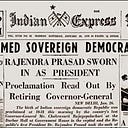Member-only story
Mention-in-Despatches III: Battle honour Sylhet

The unifying thread binding Commanding Officers of Gorkha battalions is their unwavering conviction that their battalion should have had more Param Vir Chakras or Victoria Crosses to their name. Such is their honour and courage in battle and raconteuring thereafter. In case of the 4th Battalion the 5 Gorkha Rifles (Frontier Force), to give 4/5 GR their full name, it is true.
As far as surprises go, the call which informed Major AB ‘Harry’ Harolikar in early August 1971 that he was to leave his parent battalion, 3/5 Gorkha Rifles in the Jammu sector, and assume command of 4/5 Gorkha Rifles was the biggest of his life. He was the second in command at 3/5 GR and was fully expecting to continue serving as such. He was promoted to Lieutenant Colonel and placed in command of 4/5 GR at Zakama, Nagaland. Commanding your men’s respect, and not just the battalion, is the biggest and most important battle any infantry officer can fight and it begins the day he is commissioned into his parent battalion. To be airdropped to command a new battalion, albeit from the same regiment, in the middle rising hostilities which were certain to lead to war, is really stretching it.
Sylhet lies in North Eastern Bangladesh (then East Pakistan, which made Sylhet North East, East Pakistan) — about halfway between the borders Bangladesh shares with Tripura and Meghalaya. In the months leading up to India’s decisive victory in the 1971 war, it had become an important communications outpost for the Pakistani army and a living example of the “fortress defence” which Pakistan had come to assume. Sylhet was the district HQ and its fall could herald large losses of territory in the North East — think of Sylhet as East Pakistan’s own Chicken’s Neck.
Atgram, a town in Sylhet district, was an important outpost and its capture would be the first step in a march unto Sylhet. Pakistan’s defence of this sector followed a strong point — fortress matrix. Imagine an outstretched hand, with each of the fingers being a ‘strong point’ and the base of the hand is the ‘fortress’. With the fingers drawn in, defences from the strong points collapse back and the clenched fist becomes a ‘fortress’ — to be defended at all costs. Atgram was a strong point and the…
